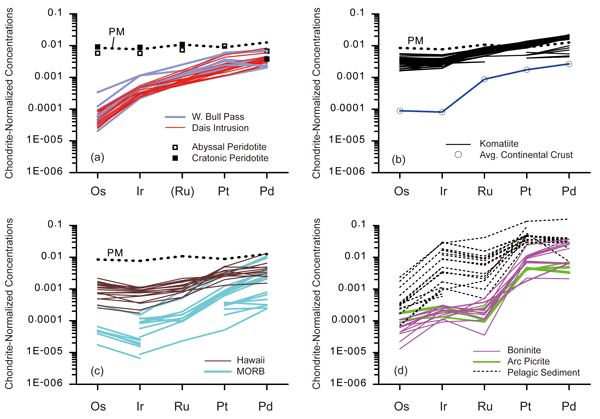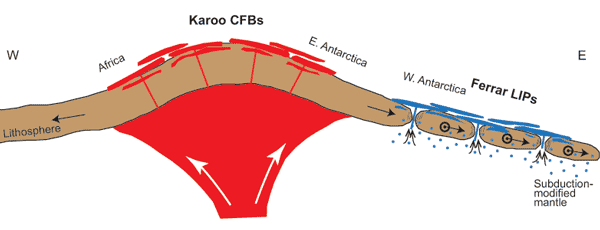 |
Fossil subduction zone origin for magmas in the Ferrar Large Igneous Province, Antarctica: Evidence from PGE and Os isotope systematics in the Basement Sill of the McMurdo Dry Valleys |
Sung Hi Choi1, Samuel B. Mukasa2, Greg Ravizza3, Thomas H. Fleming4, Bruce D. Marsh5 & Jean H. J. Bédard6
1Department of Geology and Earth Environmental Sciences, Chungnam National University, Daejeon 34134, South Korea; chois@cnu.ac.kr
2Department of Earth Sciences, University of Minnesota, Minneapolis, MN 55455, USA; mukasa@umn.edu
3Department of Geology and Geophysics, SOEST, University of Hawaii at Manoa, Honolulu, HI 96822, USA; ravizza@hawaii.edu
4Department of Earth Science, Southern Connecticut State University, New Haven, CT 06515, USA; flemingt1@southernct.edu
5Morton K. Blaustein Department of Earth and Planetary Sciences, Johns Hopkins University, Baltimore, MD 21218, USA; bmarsh@jhu.edu
6Geological Survey of Canada, 490 de la Couronne, Québec, PQ, G1K 9A9, Canada; jeanh.bedard@canada.ca
This webpage is a summary of Sung Hi Choi, Samuel B. Mukasa, Greg Ravizza, Thomas H. Fleming, Bruce D. Marsh, Jean H.J. Bédard, Fossil subduction zone origin for magmas in the Ferrar Large Igneous Province, Antarctica: Evidence from PGE and Os isotope systematics inthe Basement Sill of the McMurdo Dry Valleys, Earth and Planetary Science Letters, 506, 507–519, 2019.
Large igneous provinces (LIP) on Earth are often associated with mantle plumes and the breakup of supercontinents. Anomalously high mantle temperatures and decompression of deep-sourced dry mantle plume are often invoked for high melt production rates in LIPs (e.g., White & McKenzie, 1989). Recent studies, however, have noted that H2O can play an important role in the generation of LIP magmatism (e.g., Liu et al., 2017).
Representing one of the world’s largest continental tholeiitic basalt provinces, the Jurassic Ferrar Large Igneous Province (FLIP) is an elongate belt extending for over 3,000 km along the Transantarctic Mountains, Antarctica. Zircon and baddeleyite U-Pb dating shows that emplacement of Ferrar magmatism occurred in a short time at 182.7 ± 0.5 Ma, contemporaneously with fragmentation of the supercontinent Gondwanaland (Encarnación et al., 1996; Minor & Mukasa, 1997; Burgess et al., 2015; Ivanov et al., 2017). A number of models have shown that Ferrar magmatism is related to continental rifting and the break-up of Gondwanaland, though many also cite a mantle plume as an attractive mechanism for generating short-duration and voluminous LIP magmas while at the same time providing a mechanism for the concurrent supercontinent break-up. However, Ferrar magmatism is petrochemically, isotopically, and geographically distinct from coeval plume-derived Karoo (southern Africa) and Dronning Maud Land (DML; East Antarctica) magmas.
The Karoo and DML magmas are characterized by abundant picrites, in contrast with the predominantly basaltic andesite-to-andesitic rocks with locally abundant orthopyroxene phenocrysts of the Ferrar. Geochemically, Karoo and DML mafic magmas have relatively depleted Sr-Nd-Pb isotopic compositions (initial 87Sr/86Sr < 0.708; εNd > -4; 206Pb/204Pb < ~18.5) and high Ti/Y ratios (> ~250). The Ferrar rocks, in contrast, are distinguished by enriched isotopic compositions (initial 87Sr/86Sr ratios > 0.707; εNd < –3; 206Pb/204Pb > ~18.5), low Ti/Y ratios (< ~200), and lower overall HFSE concentrations. Proposed models for the distinctive isotopic and elemental compositions of Ferrar magmatism are controversial and include:
- high-level crustal contamination of mantle-derived magmas (Fleming et al., 1995; Antonini et al., 1999);
- melting of a depleted asthenospheric mantle contaminated by crustal components re-injected into the mantle by ancient subduction processes (Kyle et al., 1983; Hergt et al., 1989, 1991);
- interaction of a Dupal-like plume with the lithosphere (Menzies & Kyle, 1990); and
- melting of sub-Gondwanan lithospheric mantle with a supra-subduction signature (Kyle, 1980; Brewer et al., 1992; Storey et al., 1992; Molzhan et al., 1996).
Here, we present platinum-group-element (PGE) and Os-isotopic data for the Basement Sill in the McMurdo Dry Valleys (West Bull Pass area and Dais Intrusion), a part of the FLIP, that challenge the model of a plume magma source. Figure 1 compares the chondrite-normalized PGE abundance patterns for the Basement Sill samples to those of primitive mantle, abyssal and cratonic peridotites, komatiite, OIB, MORB, pelagic sediments, and arc boninite and picrite. A critical feature of the Basement Sill is its subchondritic Os/Ir ratios which are different from the chondritic Os/Ir ratio of primitive upper mantle, more refractory average abyssal peridotite or old cratonic peridotite (Figure 1a). The Os/Ir ratio of average continental crust is also nearly chondritic (Figure 1b). Therefore, the subchondritic Os/Ir ratios of the samples studied cannot be attributed to contamination with typical crustal materials, but instead are more likely to represent magma characteristics inherited from the mantle source.

Figure 1: Chondrite-normalized PGE abundance patterns. Data sources: see Choi et al. (2019). PM = primitive mantle. Click here or on Figure for enlargement.
Komatiites are widely considered to have formed by high-degree partial melting (~20–50%) of deep mantle sources, and thus should be S-undersaturated during partial melting and much of their crystallization history. Komatiites can thus give us valuable information on the relative abundances of PGEs in the mantle sources. Komatiites are characterized by unfractionated (Os/Ir)N ratios of ~1 (Figure 1b), similar to common mantle peridotites (Figure 1a). Also shown are available PGE abundance patterns for MORB (MgO = 8–10 wt%), and Hawaiian tholeiitic (MgO = 8–12 wt%) and picritic parental melt compositions (MgO >12 wt%) (Figure 1c). Although the absolute and relative PGE abundances of the lavas have been affected by the combined effects of partial melting and fractional crystallization, they are characterized by weakly suprachondritic Os/Ir ratios of ~2.0, which are completely unlike the dataset for the Ferrar LIP. Significant sub-chondritic Os/Ir ratios so far have been reported only in arc rocks and pelagic sediments (Figure 1d). In order to minimize the potential effects of AFC processes in arc rocks, the plot is limited to primitive oceanic arc picrites and boninites. Clearly, these magma types are depleted in Os relative to Ir. Although the exact mechanism responsible for Os/Ir fractionation is uncertain, subchondritic Os/Ir values appear to be an intrinsic characteristic of mafic magmas in arc settings.
The 187Os/188Os values of Basement Sill samples range from 0.1609 ± 0.003 (2σ) to 8.100 ± 1.600 (2σ). The minimum value overlaps with a previously published estimated initial 187Os/188Os ratio for Ferrar magmas of 0.145 ± 0.049 (2σ) (Brauns et al., 2000). These values are higher than the typical depleted asthenospheric mantle source value of ≈0.125 and the lithospheric mantle value of ≈0.121, ruling both out as potential sources.
The subchondritic Os/Ir ratios observed in the Basement Sill of the Ferrar LIP provide key evidence for derivation of parental magma from a heterogeneous source with arc-like characteristics. This PGE evidence is compatible with the lithophile trace element characteristics of Ferrar magmatism, such as relative enrichment in fluid-mobile elements (e.g., LILE) but depletion in fluid immobile elements (e.g., HFSE). Both are best explained as originating in arc-like mantle. Their enriched Sr-Nd-Os isotopic compositions also support derivation from a subduction-modified mantle. The long Phanerozoic history of subduction along the proto-Pacific margin of Gondwanaland, including subduction of the Phoenix Plate in the early Jurassic, offers a mechanism for geochemically modifying the mantle from which Ferrar magmas were derived.
We propose that the FLIP formed from decompression melting of mantle with a fossil subduction zone signature along the proto-Pacific margin of Gondwanaland, disaggregated by rifting related to plate rearrangements during supercontinent break-up (Figure 2). The remarkably short duration of LIP magmatic events may be due to rapid decompression of hydrated mantle allowing instantaneous large-volume melting which then peters out quickly (<1 Myr) as H2O is expelled from the source rocks and into the melt. Far field plume-induced geodetic instabilities of the lithosphere might have caused the decompression that triggered the Ferrar LIP magmatism in an extensional tectonic regime (Figure 2).

Figure 2: Schematic presentations of a geodetic instability model for the Ferrar LIP triggered by plume impingement in the Karoo region. CFB = continental flood basalt; LIP = large igneous province.
References
-
Antonini, P., Piccirillo, E.M., Petrini, R., Civetta, L., D’Antonio, M., Orsi, G., 1999. Enriched mantle – Dupal signature in the genesis of the Jurassic Ferrar tholeiites from Prince Albert Mountains (Victoria Land, Antarctica). Contrib. Mineral. Petrol. 136, 119.
-
Brauns, C.M., Hergt, J.M., Woodhead, J.D., Maas, R., 2000. Os isotopes and the origin of the Tasmanian dolerites. J. Petrol. 41, 905918.
-
Brewer, T.S., Hergt, J.M., Hawkesworth, C.J., Rex, D., Storey, B.C., 1992. Coats Land dolerites and the generation of Antarctic continental flood basalts. Geol. Soc. London Spec. Publ. 68, 185208.
-
Burgess, S.D., Bowring, S.A., Fleming, T.H., Elliot, D.H., 2015. High-precision geochronology links the Ferrar large igneous province with early-Jurassic ocean anoxia and biotic crisis. Earth Planet. Sci. Lett. 415, 9099.
-
Encarnación, J., Fleming, T.H., Elliot, D.H., Eales, H.V., 1996. Synchronous emplacement of Ferrar and Karoo dolerites and the early breakup of Gondwana. Geology 24, 535538.
-
Fleming, T.H., Foland, K.A., Elliot, D.H., 1995. Isotopic and chemical constraints on the crustal evolution and source signature of Ferrar magmas, north Victoria Land, Antarctica. Contrib. Mineral. Petrol. 121, 217236.
-
Hergt, J.M., Chappell, B.W., McCulloch, M.T., McDougall, I., Chivas, A.R., 1989. Geochemical and isotopic constraints on the origin of the Jurassic dolerites of Tasmania. J. Petrol. 30, 841883.
-
Hergt, J.M., Peate, D.W., Hawkesworth, C.J., 1991. The petrogenesis of Mesozoic Gondwana low-Ti flood basalts. Earth Planet. Sci. Lett. 105, 134148.
-
Ivanov, A.V., Meffre, S., Thompson, J., Corfu, F., Kamenetsky, V.S., Kamenetsky, M.B., Demonterova, E.I., 2017. Timing and genesis of the Karoo-Ferrar large igneous province: New high precision U-Pb data for Tasmania confirm short duration of the major magmatic pulse. Chem. Geol. 455, 3243.
-
Kyle, P.R., 1980. Development of heterogeneities in the subcontinental mantle: Evidence from the Ferrar Group, Antarctica. Contrib. Mineral. Petrol. 73, 89104.
-
Kyle, P.R., Pankhurst, R.J., Bowman, J.R., 1983. Isotopic and chemical variations in Kirkpatrick basalt group rocks from southern Victoria Land. In: Oliver, R.L., James, P.R., Jago, I.B. (Eds.), Antarctic Earth Science. Australian Academy of Sciences, pp. 234237.
-
Liu, J., Xia, Q.-K., Kuritani, T., Hanski, E., Yu, H.-R., 2017. Mantle hydration and the role of water in the generation of large igneous provinces. Nat. Commun. 8: 1824. 10.1038/s41467-017-01940-3.
-
Menzies, M.A., Kyle, P.R., 1990. Continental volcanism: a crust-mantle probe. In: Menzies, M.A. (Ed.), Continental Mantle. Clarendon Press, Oxford, pp. 157177.
-
Minor, D.R., Mukasa, S.B., 1997. Zircon U-Pb and hornblende 40Ar-39Ar ages for the Dufek layered mafic intrusion, Antarctica: Implications for the age of the Ferrar large igneous province. Geochim. Cosmochim. Acta 61, 24972504.
-
Molzahn, M., Reisberg, L., Wörner, G., 1996. Os, Sr, Nd, Pb, O isotope and trace element data from the Ferrar flood basalts, Antarctica: evidence for an enriched subcontinental lithospheric source. Earth Planet. Sci. Lett. 144, 529546.
-
Storey, B.C., Alabaster, T., Hole, M.J., Pankhurst, R.J., Wever, H.E., 1992. Role of subduction-plate boundary forces during the initial stages of Gondwana break-up: evidence from the proto-Pacific margin of Antarctica. In: Storey, B.C., Alabaster, T., Pankhurst, R.J. (Eds.), Magmatism and the Causes of Continental Break-up. Geol. Soc. London Spec. Publ. 68, 149163.
-
White, R., McKenzie, D., 1989. Magmatism at rift zones: The generation of volcanic continental margins and flood basalts. J. Geohys. Res. 94, 76857729.
last updated 25th
January, 2019 |
